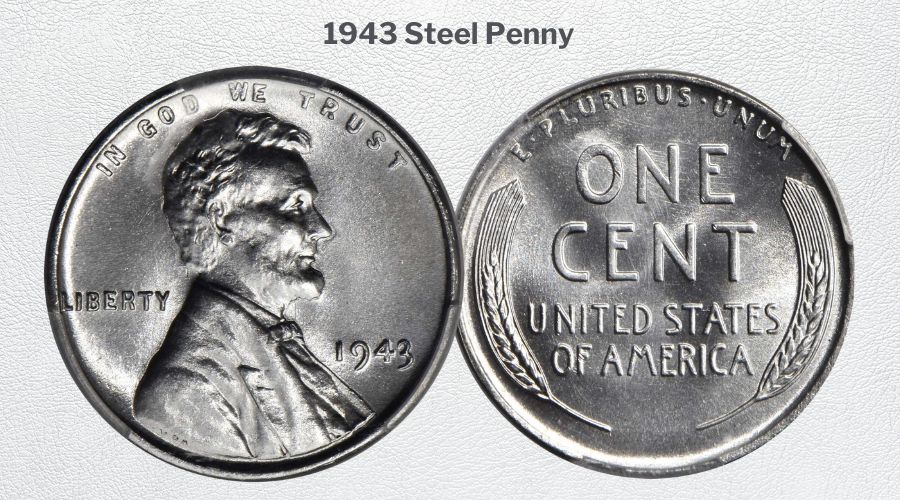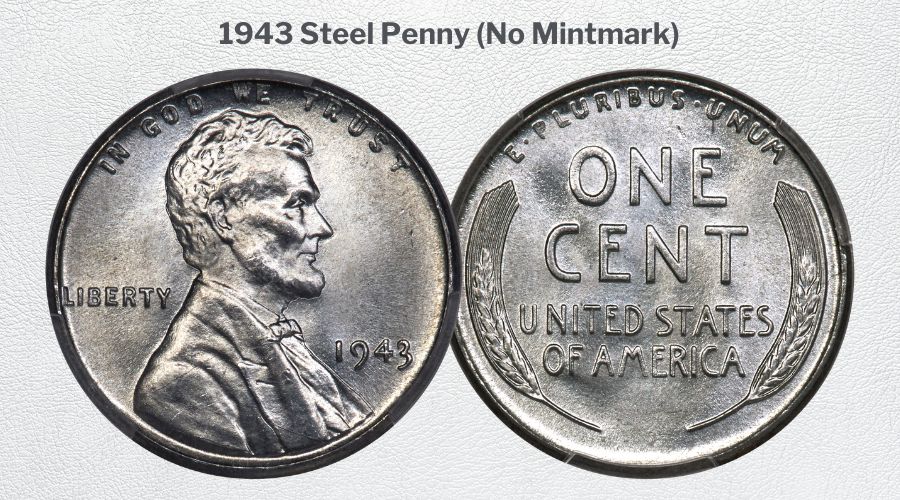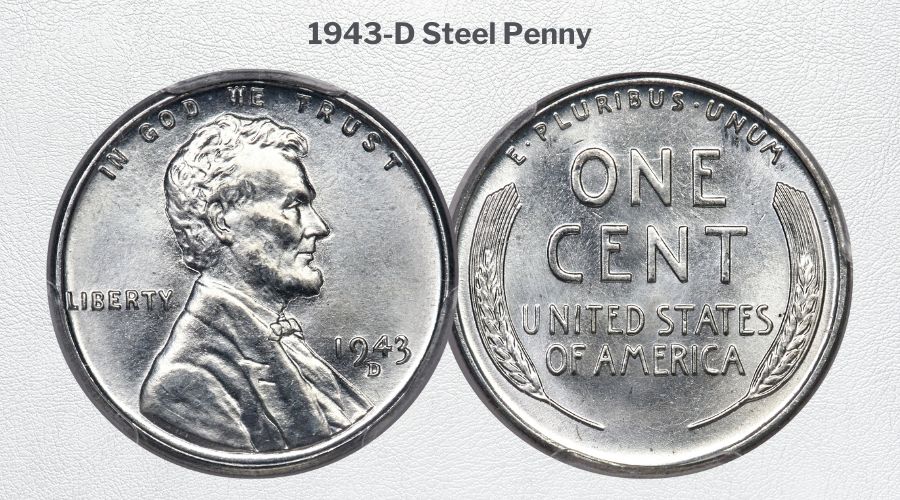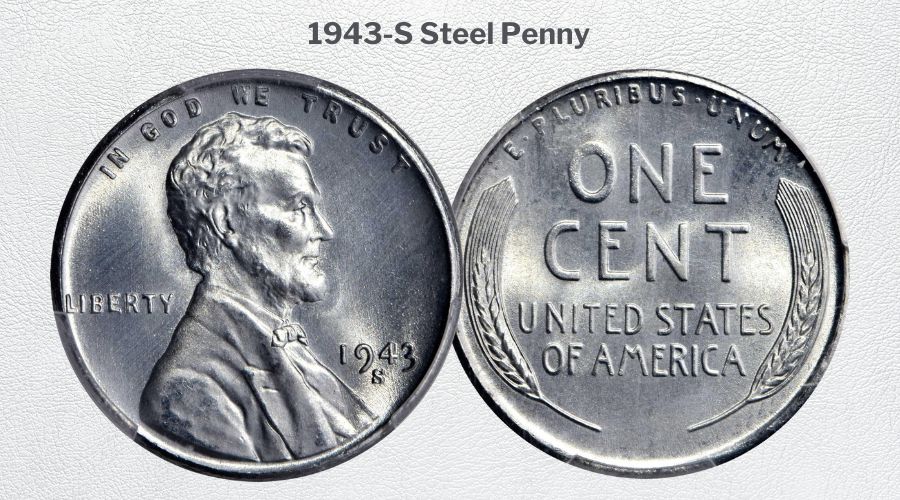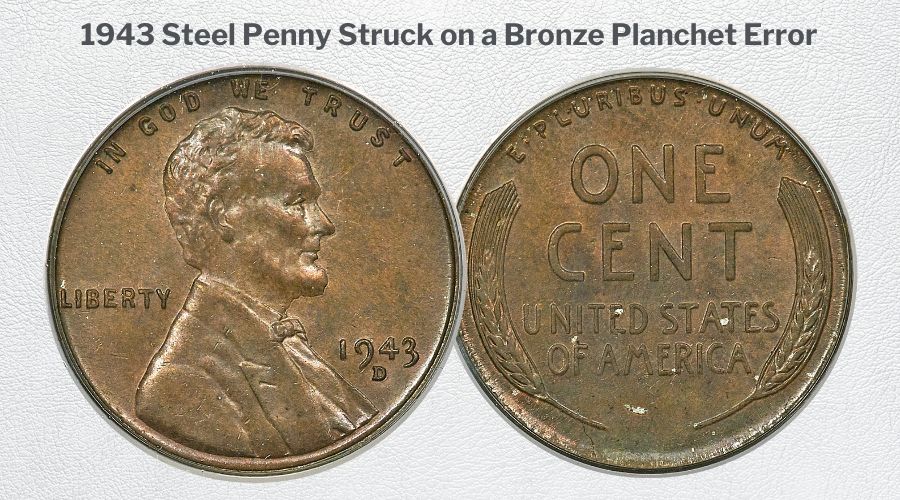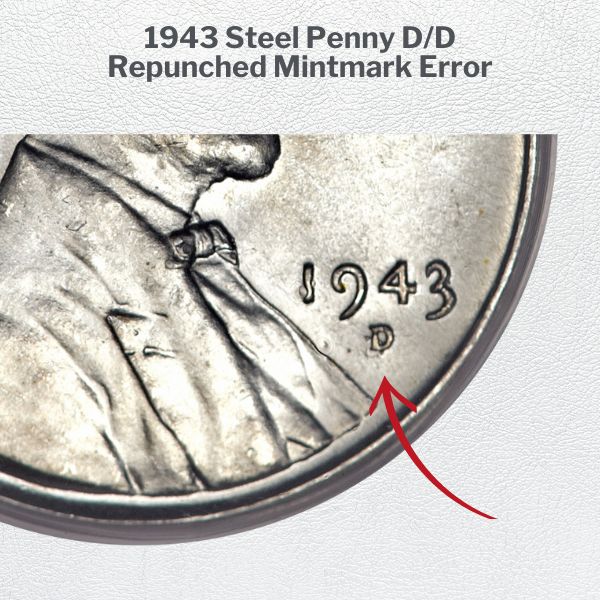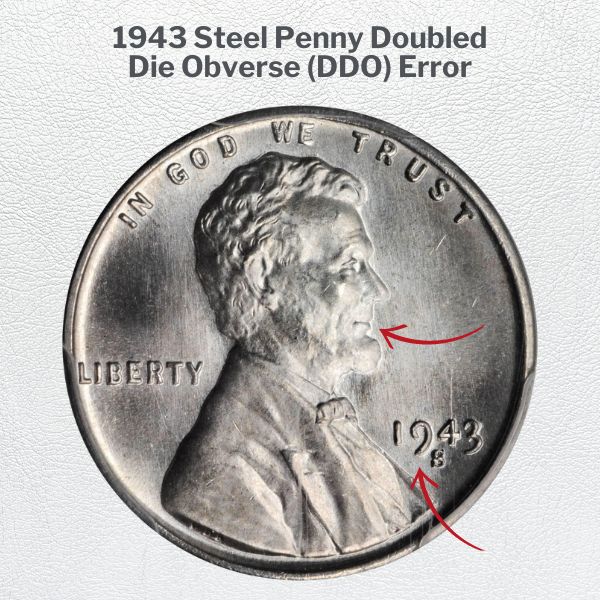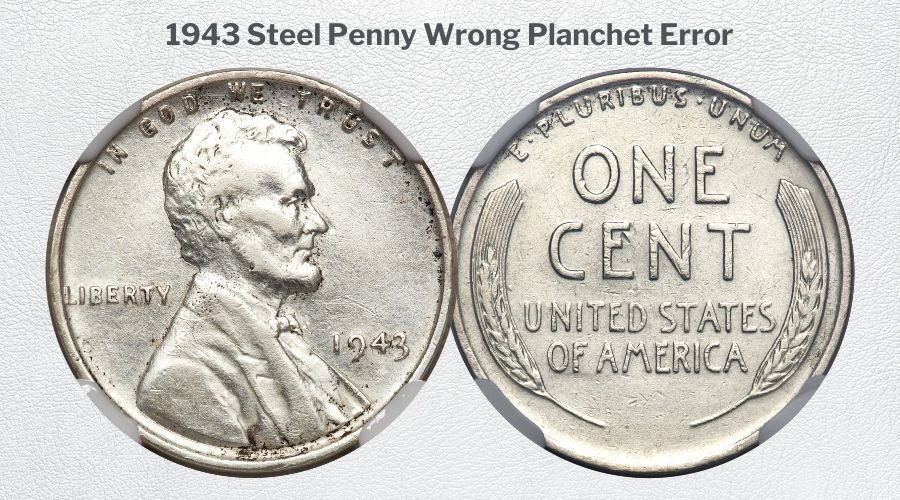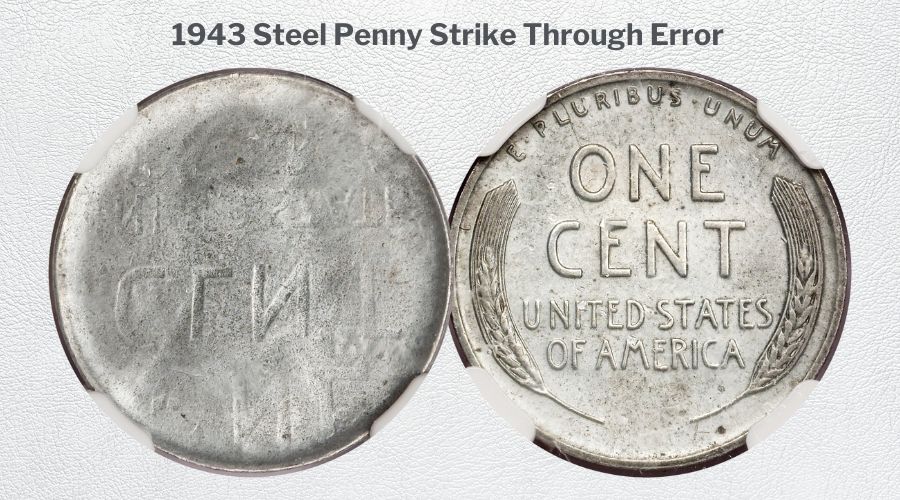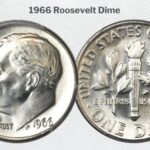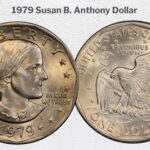The value of 1943 Steel Pennies in circulated conditions ranges from $0.05 to $1. Those in common uncirculated conditions are worth up to $27, however, in the highest grades, these coins can fetch up to $35,000.
To date, the highest price ever realized for a 1943 steel penny was $33,600 in 2020 at Stack’s Bowers. The coin was an MS68+ coin from Philadelphia, featuring smooth surfaces free of any blemishes and a highly lustrous appearances with satin to softly frosted mint luster.
Despite their historic value, steel coins from that year are overshadowed by error coins. A minting mistake led to the creation of several 1943 Bronze pennies, some selling for up to $1.7 million, with even the lowest grades fetching more than $60,000.
Continue reading to discover why the 1943 steel penny has a substantial collectors’ following and learn about how World War II impacted its production. Delve into the history of its existence and explore the various errors that contribute to the coin’s increased value.
1943 Penny Details
- Category/Series: Lincoln Cents, Wheat Reverse (1909 – 1958)
- Mint: Philadelphia, San Francisco, Denver
- Mintage: 684,628,670
- Designer: Victor David Brenner
- Composition: Zinc-coated steel (99% steel planchet with a thin layer of zinc coating)
- Weight: 2.70 grams
- Diameter: 19.05 millimeters
- Edge: Plain
History
From 1909 to 1958, Lincoln cents were made of bronze (95% copper plus 5% tin and zinc). It was only in 1943 that the U.S. Mint decided to create the first and only steel cent series since its inception.
The United States did not enter World War II until December 1941. By that time, the country was deeply involved in providing military supplies and assistance to the Allies.
A significant supply from the country included copper and other elements like nickel, which were crucial in various services, including ammunition production.
The supply of these materials had to be redirected from the coinage industry to support the military. This prompted the U.S. Mint to explore alternative but temporary materials for striking coins.
Metal Compositions
During this phase, several materials were experimented with to substitute the copper & tin-zinc composition. This brought about the 1943 Experimental planchets.
These planchets (blanks) feature different metal compositions including aluminum, plastic, glass, pressed fiber, copper-coated steel, iron & antimony, zinc-antimony on coated steel, silver-zinc & copper, and zinc-coated steel.
Through various tests and experimentation, the Mint settled on the zinc-coated steel to make the 1943 steel pennies.
Production began in all three mints and the coins were issued for circulation.
Poor Reception
The use of zinc-coated steel brought out some challenges. The two materials reacted with one another and the environment leading to zinc corrosion, discoloration, and rust.
The lustrous, shiny silver-white coins quickly lost their appealing finish during circulation. This led to a dull, powdery coin that quickly lost its surface material to reveal a dark gray planchet beneath.
Also, the silvery finish of the steel pennies made it easier for people to confuse the 1943 steel pennies with dimes (when new) and nickels (when worn out).
As a result, the U.S. Mint decided to discontinue the production of steel pennies and resumed the minting of bronze (95% copper and 5% tin & zinc) pennies in 1944. This change marked the end of the steel cent era, making the 1943 Steel Penny a special onetime only coin.
1943 Penny Design and Minting
The obverse design features President Abraham Lincoln with inscriptions: “IN GOD WE TRUST”, “LIBERTY”, and “1943” followed by a mintmark underneath the date for Denver and San Francisco.
The reverse design has a large “ONE CENT” inscription at the center, “UNITED STATES OF AMERICA” under it, two wheat stalks on either sides, and “E PLURIBUS UNUM” at the top center.
| Mint | Mint Mark | Total Mintage |
| Philadelphia | N/A | 684,628,670 |
| Denver | D | 217,660,000 |
| San Francisco | S | 191,550,000 |
| Total Mintage | 684,628,670 |
What Makes the 1943 Steel Penny Valuable?
Main factors contributing to the value of 1943 steel cents include:
1. Historic Significance – World War II Coins
Coins between 1941 and 1945 are called wartime coins, including the 1943 steel pennies. They are popular among collectors for their novelty, especially the rarer ones. They stand as concrete symbols, offering a reflection on a period marked by the uncertainty of World War II’s outcome.
2. Experimental Planchets
The 1943 experimental cents did not go into production. They were just concept pieces, kept for numismatic purposes. However, a few pieces have turned up on the market over the years, being sold in pairs of at least five to twenty.
They are worth thousands of dollars due to their rarity. They are also a testament of what could have been!
Keep in mind: They are more valuable in pairs, as a collection.
3. 1943 Bronze Pennies
These are the most famous and valuable of all 1943 Lincoln Cents. They are also the most valuable Lincoln cents of all time. Not only that, they are the most valuable of all off-metal errors in U.S. history.
So, how did the 1943 bronze pennies come about?
They came about due to an off-metal error – an error where a coin is struck on a planchet (blank) that is different than its own.
During the transition from using one planchet to another, a few bronze planchets from the previous year (1942) remained lodged in the tote bins. They went unnoticed when the new 1943 zinc-coated planchets were added on top.
1943 pennies were then accidentally struck using the unnoticed bronze planchets, leading to the creation of the 1943 Bronze Pennies (sometimes referred to as “copper” or copper-alloy due to their high copper content). This happened in the Philadelphia and San Francisco Mint.
Philadelphia was the most affected. The population is unknown but about 40 have been confirmed to exist.
1943 cents with this error are extremely valuable, worth more than $60,000, valued for their extreme rarity and unique appearance.
4. Coin Condition
The biggest determiner of any coin’s value is its condition, graded according to the Sheldon Scale – read the complete guide on how coin grading works.
1943 steel cents are more valuable in MS68 or higher. These are highly priced for their rarity and incredible eye appeal featuring full original mint luster, flawless surfaces, minor to no blemishes, and sharp strikes.
5. Rarity – Errors & Varieties
With more than 680 million minted, 1943 steel pennies are not considered rare. Nonetheless, there are a limited number of coins that fall into die varieties, along with others exhibiting rare mint errors.
Examples include Strike Through, DDO, and D/D repunched mintmarks. Several specimens with these features have sold for thousands of dollars.
6. Mint Mark
The 1943-S are the fewest due to lower mintage, making them more valuable in circulation. They are also scarcer than 1943 and 1943-D pennies in terms of total number of Mint State coins still in existence.
1943 Steel Pennies & Their Values
The three mints produced 1943 steel pennies giving us the 1943, 1943-D, and 1943-S.
There were no Proof coins this year, the U.S. Mint stopped producing them between 1943 and 1949. Instead, they redirected their efforts into striking millions of medals for military awards.
You’ll notice DDR and DDR die varieties in all three mints, plus the valuable D/D RPM from the Denver Mint.
Considering all the above factors that influence the coins’ value, we have curated the value chart below, showing the current market value of each 1943 steel penny:
| Coin | Circulated | AU50 – AU58 | MS60 – MS64 | MS65 + |
| 1943 Steel Penny (No Mintmark) | $0.05 – $1 | $1 – $8 | $1 – $27 | $27.50 – $35,500 |
| 1943-D Steel Penny | $0.05 – $1 | $1 – $8 | $1 – $27 | $23 – $15,500 |
| 1943-S Steel Penny | $0.05 – $1 | $1 – $8 | $3.75 – $27 | $30 – $35,000 |
1. 1943 Steel Penny (No Mintmark) Value
As per NGC price guides, the 1943 Steel Pennies are worth $0.05 – $0.40 in circulated conditions. About Uncirculated coins (AU50 – AU58) are worth $1 – $8.
An MS60-graded coin is worth $1 while the highest grade, MS68, is worth $3,200-$35,000.
The highest sale was for an MS68+ coin sold for $33,600 – it is the finest known 1943 steel cent with the most stunning eye appeal and technical quality, fully lustrous and virtually pristine.
Rarity also adds to these coins’ value.
For example, there are over 3,000 known specimens in MS67 (worth $200 – $600) and less than 200 specimens in MS68 (worth $3,200 – $35,000).
Evidently, the scarcity at MS68 significantly increases the price from a few hundred to thousands of dollars.
The price increases even higher when the coin belongs to one of the die varieties – DDO or DDR (more on these errors in the section below).
A coin with an error or variety can be more expensive than a regular coin with a higher grade. This is because major errors make coins unique and attractive, leading to a rarer and more valuable cent that gains more attention and popularity.
Below are the highest prices ever realized for a regular 1943 Steel penny:
| Grade | Price | Firm | Sale Date |
| MS68+ | $33,600 | Stack’s Bowers | 2020 |
| MS68 | $7,200 | Heritage Auctions | 2022 |
| MS68 | $7,200 | Heritage Auctions | 2019 |
| MS68 | $6,000 | Heritage Auctions | 2021 |
| MS68 | $5,760 | Heritage Auctions | 2019 |
2. 1943-D Steel Penny Value
The value of 1943-D steel pennies are similar to that of Philadelphia coins. Circulated grades are worth $0.05 – $0.40, $1 – $8 in About Uncirculated, and $1 – $27 in MS60 – MS64.
The only difference between 1943 and 1943-D is that 1943-D are more available in MS68, with more than 300 known examples in NGC and PCGS data bases.
An MS68 is worth $1,900 – $15,500, valued for its rarity and attractive surfaces featuring highest mint luster and sharpest strikes.
The most valuable was sold for $6,600 in 2019 – MS68 with full design definition and bright satin silver surfaces, the highest graded piece ever.
Keep in mind that lower grades can be worth a lot too.
Examples include the 1943-D/D Steel pennies with repunched mint marks. An MS67 specimen with this error sold for $18,800 in 2012. If you do not have the finest grades, then the best chance of profitability is to look for error coins.
Below are the highest prices ever realized for a regular 1943-D Steel penny:
| Grade | Price | Firm | Sale Date |
| MS68 | $6,600 | Heritage Auctions | 2019 |
| MS68 | $4,312.50 | Heritage Auctions | 2012 |
| MS68 | $4,200 | Heritage Auctions | 2023 |
| MS68 | $4,080 | Heritage Auctions | 2019 |
| MS68 | $3,995 | Legends Auctions | 2022 |
3. 1943-S Penny Value
Circulated and About Uncirculated prices are similar to 1943 and 1943-D, however, at Mint State, 1943-S begin at $3 for MS60 and go up to $35,000 in MS68.
If you happen to have Mint State varieties of all three coins then the one with the S mintmark will often sell for more at the same grade.
Lower grades that are more valuable than MS68 are “Wrong Planchet” error coins and DDO varieties. A DDO example sold for $9,500 in 2004 while being a mere MS66. But that is nothing compared to the AU53 with a “Struck on Dime Planchet” error that sold for $9,200 in 2009. More on these errors below.
The best seller is the MS68+ sold for $19,200 in 2021 – it is the single highest graded to date with a smooth and pristine appearance.
Here are the highest prices ever realized for a regular 1943-S Steel penny:
| Grade | Price | Firm | Sale Date |
| MS68+ | $19,200 | Stack’s Bowers | 2021 |
| MS68 | $7,475 | Heritage Auctions | 2008 |
| MS68 | $6,462.50 | Heritage Auctions | 2013 |
| MS68 | $5,405 | Heritage Auctions | 2015 |
| MS68 | $5,400 | Heritage Auctions | 2019 |
The best price, as you can see, came from a recent auction. This means the demand is still high for MS68 cents. This is supported by PCGS price trends that indicate a steady increase in valuation.
Also Read: 1944 Steel Penny Value
1943 Steel Penny Errors
Error coins are valuated differently from regular 1943 steel cents. They are typically more expensive but are also rare. Below is a list of the most valuable errors in 1943 cents:
1. Struck on a Bronze Planchet
Almost no other coin in history has ever been avidly sought by collectors like the 1943 bronze cents.
These are the coins formed due to the 1943 off-metal error, featuring olive-brown surfaces instead of the silver-white of the steel pennies.
About 40 are known to exist with most coming from Philadelphia, followed by a handful from San Francesco, and only one from Denver.
Of course, the most expensive is the one and only 1943-D, graded at MS64 and worth up to $2,000,000 in today’s market.
Its highest sale record was $1.7 million at a private auction in September 2010. But, the biggest sale in a public auction was $840,000 in 2021 at Heritage. It is the most valuable bronze penny because there is literally no other like it.
It is speculated that the reason why there is only one Bronze penny from Denver is because the error didn’t happen there. Instead, a worker deliberately struck the coin knowing how valuable it would be in the future.
Below is a value chart showing the price range across different grades:
| Coin | Circulated | AU50 – AU58 | MS60 – MS64 |
| 1943 Bronze Penny (No Mintmark) | $60,000 – $250,000 | $275,000 –$400,000 | $425,000 –$1,000,000 |
| 1943-D Bronze Penny | N/A | N/A | $1,050,000 –$2,000,000 |
| 1943-S Bronze Penny | $150,000 | $227,500 –$475,000 | $1,000,000 –$1,100,000 |
Due to the high value of these coins, there are many forgeries in the market, some more convincing than others. You won’t be able to easily spot a fake by looking at its appearance. However, there is an easy test to combat this.
So, how do you differentiate between a real 1943 bronze penny from a fake?
Use a magnet – Real bronze pennies do not have magnetic properties, hence won’t stick to magnets. Fake ones, on the other hand, are typically forged from 1943 steel pennies (which are magnetic). They are then coated with a convincingly brown plating, but since they are mostly steel, they will stick to magnets.
2. D/D Repunched Mintmark
Before 1990, mintmarks on circulation coins were punched by hand into the dies. If the worker didn’t center the mark perfectly then there would be a separation or doubling of the mintmark. 1943-D pennies with this error have a visible D/D mintmark that appears doubled.
The value of the coin depends on how noticeable the error is, with the highest price going to the most visible.
The highest sale record was for an MS67 coin sold for $21,275 in 2011– the finest D/D to date, with a boldly impressed second mintmark on the northeast of the first punch. It is the clearest D/D of them all. At its high grade, it features a lustrous surface with minuscule blemishes and a bold strike throughout.
Other examples include:
- MS67 sold for $18,800 and $18,975 in 2012
- MS67 sold for $14,100 in 2015
- MS67 sold for $10,200 in 2018
- MS66 sold for $5,462.50 in 2001.
3. Doubled Die Obverse (DDO)
DDO errors were only noted in the 1943 and 1943-S coins.
This is where the obverse dies used in coinage aren’t properly manufactured leading to doubled elements, lettering, numbers, and design elements on the coin’s heads side.
The highest auction price was $9,500.15 in 2004 – MS66 coin with all elements and letters on the obverse widely die doubled. It still has its original luster with a pristine design.
Another MS67 sold for $2,056.25 in 2013, but its lowly priced despite its higher grade because the doubling is most pronounced on Lincoln’s Lower lip and numeral 19 on the date.
4. Other “Wrong Planchet” Errors
Not all planchet errors are the same. Apart from the use of bronze planchets, some 1943 cents were also struck using other foreign planchets that wound up in production.
An examples of this is the “Struck on a Curacao 25 Cent Planchet” an XF40 coin sold for $14,950 in 2010. This coin was made from the collaboration between Curacao and the United States. During World War II the U.S. helped Curacao with coin production while they helped supply oil to the Allies.
During mintage, left-over Curacao 25 Cent planchets wound up in the same bin as those used to strike 1943 steel pennies.
This mixing happened often in 1943, frequently with our own dime planchets, creating the following examples:
- Struck on a 1943 Mercury Dime – MS62 sold for $28,750.
- Struck on a Netherlands 25 Cent Planchet – MS61 sold for $24,000 in 2018.
- Struck on Silver Dime Planchet – AU50 sold for $15,275 in 2013, MS62 sold for $5,581 in 2013. 1943-S MS61 sold for $7,763 in 2002.
- Struck on an Australian Sixpence Planchet – AU50, 1943-D coin, sold for $4,887.50 in 2007.
5. Strike Through
A Strike Through error happens when a foreign material is stuck between the die and planchet. When the coin is struck an impression of that material is left on the coin.
An example is the “Obverse Struck through Capped Die” – MS63 sold for $2,530 in 2009. In this case the reverse was struck correctly but the obverse wasn’t due to an obstruction. The error went further to include a Die Cap, an error where the strike has gone so far that outer portions of the coin roll over creating a cap-like appearance.
Conclusion
No other Lincoln cent is worth investing in more than the 1943-D Bronze Penny. It is the most valuable penny in U.S. history worth $2 million dollars.
However, for the beginner to mid-tier collector, the best 1943 cents to invest in are circulation pennies with unique errors like D/D, DDO, or Strike Throughs. Circulation coins without errors are not worth investing in since they are all worth less than $1.

